Rediscovering My Old Double Exposure Photos of Georgia O'Keeffe Produces Memories of My Creativity I Hadn't Even Known Had Faded
... "it’s really tough to describe what happened but if I were a Russian nesting doll, the big head was popped off to reveal that there was a same-but-different little me inside ..."
One of the beautiful things that happens when moving from one house to another is that things that were buried on shelves and long forgotten find their way up to the surface and back into my awareness. Over the weekend, I came across an album of photography explorations I did when I was about 19 years old, starting with a whole series of double exposure photographs of Georgia O’Keeffe and her work, and it brought back so many creative memories, weaving together some loose threads in my personal artistic world that I hadn’t even realized were still dangling. I’ll share the story of that work with you here today, a few images along with some additional images from that time, and the memories I’m working through about what photography meant to me then and could mean to me now.
Double Exposure Photographs on Film
I remember a few key cameras from my childhood. There was a rectangular black Kodak point-and-shoot that we kept in the hall closet and used most regularly and a clunky Polaroid that I adored and then there was this old film camera (a Minolta maybe?) that was fancier and more expensive and had to be adjusted manually and I don’t actually remember anyone ever using it until I was about 16 and pulled it out of that same hall closet and began to fiddle around with it.
We had the Internet back then, I think; we got it sometime while I was in high school, but it was expensive to use it and there wasn’t all that much information on it and it would never have occurred to me to go online and Google how to use a film camera in order to rapidly learn what F-stops meant.
Truth is, I probably never really learned, but I enjoyed fiddling around with that camera’s settings. My favorite was the self-timer; long before “selfie” found its way into my vocabulary, I was a teenager who loved taking photographs of myself. I’d set the camera up on my desk, positioned towards the couch that I was using as a bed in my room at the time, run over to the couch and pose. I’d do this a few times, but not too many, because there were only 24 or 36 pictures available on a roll of film and then the film would have to be taken to Walgreens where it was expensive to process and I wouldn’t receive the photos for a week.
One time, it seemed like I was able to take a lot more than 24 photos, and I had no idea why, then when I got that roll of film back, I discovered that the film hadn’t been progressing like it was supposed to so one photo had been taken on top of another, a serendipitous flaw in the loading of the film that instantly made me fall in love with double exposure photography. And so, for a few years, I played around with that. I would take a photo, wind the film backwards and take another right on top of it. Or I would take a roll of photos then rewind the film and take another roll on top of it. I rarely had a good idea about how the images would look when they finally emerged, a week later, although I began to get an intuitive sense of what I was going for.
I Wanted to Be a Photographer Back Then
I honestly had kind of forgotten that I ever wanted to be a photographer. I loved photography, but I never studied it formally and the only informal study I did was taking as many photos as I could afford to get printed. I just moved to a new home and the heaviest boxes that moved with me were four huge boxes of photo albums; I’ve taken so many photos throughout my life despite forgetting that it’s something I love.
I don’t recall what kind of photographer I thought I wanted to be back then, back in the days before there were stock photo sites (although I remember circa 2008 thinking I should try to make money putting photos on those sites and then never did). This was about a decade prior to that and I took portrait photos of my sister and both landscape and close-up images of Tucson’s desert nature, especially the saguaro cacti.
At 19, I was working at the “Barnes and Noble cafe serving Starbucks” which was the first “Starbucks” in Tucson, but we weren’t allowed to call it a Starbucks, yet, and I was ready for a change. I would get the weekend newspaper and sit down with the jobs section and use a red marker to circle possibilities, and one day I came across an ad for a portrait photographer. I applied. I got the job. It was both extremely exciting and not glamorous at all and I learned basically nothing about photography from the work.
Walmart Portrait Studios
At that time, Walmart stores had portrait studios in them, where people could take their children and have their photographs done “school photo style” for holidays or for whatever, I suppose. The stores in larger cities, like Tucson, had permanent year-round portrait studios. However, the stores in all of the small towns just had someone come to them a few times a year, and set up a portrait studio for a week at a time. I was that someone.
At 19, I would load up my tiny little Toyota Paseo with a terribly large roll of “backgrounds” and so much bulky camera equipment that it really didn’t fit into the car without Tetris-style precision in packing. Later, that car would burn up while I was on the road (a story for another time) and I got a Nissan Thunderbird pickup truck that made the packing much easier although the equipment was still heavy and bulky for my 4’11” teenage self. I’d take off in the vehicle for a variety of small towns throughout Arizona, playing cassettes or the radio, sometimes watching the moon rise while I drove through the night, arriving in the parking lot of a Walmart as it was about to open. I’d set up my “studio” and photograph people for 4-5 days, usually children although in some towns it was a lot of senior citizens, and sometimes it was family portraits. Then I’d pack back up, go home to Tucson for a day or two, turn around and do it again.
I felt very fancy saying that I was a “traveling photographer” or “portrait photographer”. I felt very fancy getting a per diem hotel payment of $50 per night (and then I’d stay in the cheapest places I could find - I remember one very sketchy motel that was $19 per night - and pocket the rest of the money.) There were many reasons that experience was great for me, getting to be a young woman on the road, feeling independent. I was also lonely a lot of the time and quickly disenchanted with how creatively unfulfilling this type of photography was. And that holiday season, I learned that my photos weren’t even good.
The way it worked was that I would go take the photos in a small town - Winslow or Douglas or Cottonwood and Kingman - and then a couple of weeks later a salesperson would return to the store with the now-printed photographs because things weren’t digital in those days and they didn’t move quickly. The salesperson would bring packets of photos in different sizes and the people that I’d photographed would come to pick up their packets and the salesperson’s job was to try to upsell them more photos. That holiday season, in order to pick up some extra money on the weeks when they weren’t having us do photographs, I accompanied a seller to learn that job. At first, we were selling some other photographer’s photos, but eventually I landed at a store where I had taken the photos … and looking at them, that’s when I learned that the super minimal training that they’d given me on the camera didn’t translate to amazing portrait photos that people would want on their walls.
I didn’t know anything about composition - evidenced, for example, by the time that I photographed my siblings for Christmas images for our parents and not only are we all in weird positions but the way I used the prop stools made my sister look taller and huger than my brother, which wasn’t true of real life and just looked odd to all of us. We had props - toys, tiaras, I forget what exactly - and in some of the photos that I looked at during the week I sold my images, the props were clearly out of place, sometimes dominating the frame where the child should have been center stage. I could obviously tell some of these errors myself. Others were pointed out to me by the parents who came in to pick up their photo packets and were not at all happy with what they received. No matter, I returned to being a photographer a few weeks later when the new season began, and although I attempted to do better than before based on my own thoughts of what might be wrong, no one ever helped me improve my photography. Teaching me to be a photographer really wasn't the point of their job.
Photography as a Creative Lifeline
Eventually I realized that there was nothing artistically inspiring about the work that I was doing. However, I continued to love photography. While out on the road, I would take photos of nature, of signs that made me smile, of the letters on all of the mountains that have a letter on them (attempting, but not succeeding, to find an A-Z series.) When I would return home, I would play with photography in a more artistic way, returning to that old love of self-portraits and double exposure photography. This continued for a couple of years after I’d quit the traveling Walmart job. I was experiencing depression, although I wouldn’t call it that for nearly another decade, and exploring my creativity helped give me joy and purpose at times.
It was at this time that I created my Georgia O’Keeffe double exposure series. I had fallen in love with her work at some point. I honestly can’t remember if I owned a computer at the time. I must have soon after since I decided to start college and I know that I wrote papers on one, but I think there was a period after I moved into my own home at 18 and before I started college that I didn’t have one. I certainly didn’t have Internet that would allow me to rapidly look up as much information as I could possibly want to know about O’Keeffe and her work. I remember driving down to the Main Library in Tucson, parking in the underground garage (one of the few that existed in Tucson at the time), and exploring the shelves for information about her. I remember trekking home big art books filled with her work, mostly her flowers and some of her skulls. And I remember a book of Stieglitz’s photos of her. I used these books to create my series.
NOTE ON PHOTO SOURCES: I didn’t keep any records of which books I used to source the photos for my Georgia O’Keeffe series. I am almost certain that the photos are from Georgia O'Keeffe, a portrait, a 1978 book by Stieglitz. I have tried to figure out which books I might have used to photograph her paintings but I’m not sure; all I know is that they would have been published before 2000 and were likely large coffee table books.
I would position my camera over the open book, zooming in, trying to get exactly the right spot because there was no cropping except with scissors perhaps, and I would photograph her flowers, then I would roll back the film and photograph the portraits of her, trying to find the best composition to merge the colorful flowers with the black and white portraits. I’d repeat with the photos of her first and then the flowers on top. I don’t honestly remember if I would take one photo, roll back the film, and take the second photo right away, or if I would take the whole roll and then let magic disperse the second set of images onto the first. I think it was a combination of both as I experimented with my creative ideas.
Later on in the series, I would take double exposure photographs of the photographs I’d already taken. So, I would have a set of double exposure photos that I’d already done, and I would frame one in my camera and take a photo of it, roll the film back, repeat with another photo and create a double exposure of two double exposure photos. I also did collage style images, laying two or four or more photos out into squares or rectangles and using my camera to capture the entire layout as one new 4” x 6” image.
Younger Georgia, Older Georgia, Younger Me, Older Me
There were portraits of the artist at different ages, and there were a handful of her young and her old that I loved to juxtapose. I would use the image of the same flower over each, seeing what emerged. Sometimes I would pair the young and old versions of her without flowers, placing her younger self inside of her older self. I was going somewhere with all of this.
And then I just stopped. I don’t remember why I stopped taking those photos - the series itself or the double exposure images. Maybe, likely, my depression got so bad that I had no energy or interest in creating anymore. Maybe I was struggling for money and it was becoming too expensive to constantly get images printed at Walgreens. Maybe it was when I went back to school and I refocused my energy on whatever I was learning at the time. Or maybe it was before that when I’d taken a job at a trophy shop and I’d met a man and moved him in and I’d gotten all wrapped up in him and then he’d robbed my neighbors and instead of letting him go, I spent nearly two years visiting him every weekend in prison and spent all of my money paying for our prison phone calls. Oh yeah, maybe it was that.
Occasionally over the years I would come across this album of photos or I would think of them in passing. It’s not that I ever completely forgot that I’d done this work. I just didn’t think about it much. It was something I’d done when I was a kid. And then, this past weekend, a friend had come over to play art with me and I was looking through the boxes of stuff that aren’t quite unpacked from my move and the album of Georgia O’Keeffe images floated to the surface of the box and back into my more conscious awareness. I pulled it out and I showed the images to my friend and I told some stories about them. And it’s really tough to describe what happened but if I were a Russian nesting doll, the big head was popped off to reveal that there was a same-but-different little me inside and I was able to hold both versions of me, and I could see that sometimes they are side by side in linear ages of my life but sometimes, most of the time, they are ensconced within one another, a double exposure of the self.
I wanted to be a photographer but I also wanted to be a writer. I have since written about ten books, the newest of which is The Artist’s Mind: The Creative Lives and Mental Health of Famous Artists, a book that has a chapter on the work and mind of Georgia O’Keeffe. When writing that chapter, I don’t recall ever remembering my own series of work about her from more than twenty years before. And yet, there is a through line there, the photography I created in my own depression of the work that she did when she was both young and old leading in some mysterious way to the book chapter on her depression and anxiety as an artist that I wrote more recently.
A Body of Work
I often think of all of my work as one big body of work. In the living-forward of a creative life, sometimes it can feel like I’m flailing from one thing to the next, trying to earn an income, trying to express myself differently as I learn new things and change and grow and develop emerging interests and ideas. I don’t love everything I’ve written, let alone everything I’ve created. Books about ghosts that haunt the Bay Area, a book about Internet Addiction, books started and never finished and advanced repaid (on elder abuse, on green building), books and magazines and articles galore about crochet as therapy, craft for healing, a book of the work I did in the first year of my first graduate degree which I intended to follow up with the second year’s work but never did. I have launched so many blogs that I let fall by the wayside or sold or keep coming back to. I have started and stopped so many different freelance jobs and personal projects and things that are a weird mix of the two.
When it begins to feel like my work makes no sense and things are pointless and nothing connects to anything else, I remember that I believe in the body of work. I believe that the looking-back is different than the living-forward. I imagine that I’m 90 years old and having a retrospective of my work or that someone has posthumously discovered me and decided to research and archive and showcase everything I’ve created. And in the doing so, the narrative threads emerge and it becomes clear how one thing became another thing and the themes of my life and beliefs and creativity all become clear - they become easy chapter titles or rooms in an exhibit, things I often can’t see in the living-forward, in the creative messy middle.
Over the years, I’ve created a lot of visual art, something that I often forget to share because I think of it as play instead of work and think of writing as work even though it’s often play. More and more, I realize that this - collage, scrapbooks, crochet, weaving, series of photos, found poetry, altered art books, Zentangles, painting - is all part of my body of work as well. It’s not just that it’s something I’ve also done but that it all ties together in the big process of me making myself over the years. And being in my mid-forties is a really exciting time because I have enough of a body of work behind me that I can kind of look back and begin to see some of those themes emerge and yet I, presumably, hopefully, have enough work ahead of me to be curious about what else is going to emerge with time.
If you read this far, perhaps you liked the work. The work does take work. It only continues with support, so please consider subscribing. My annual rate starts at $10 per year.





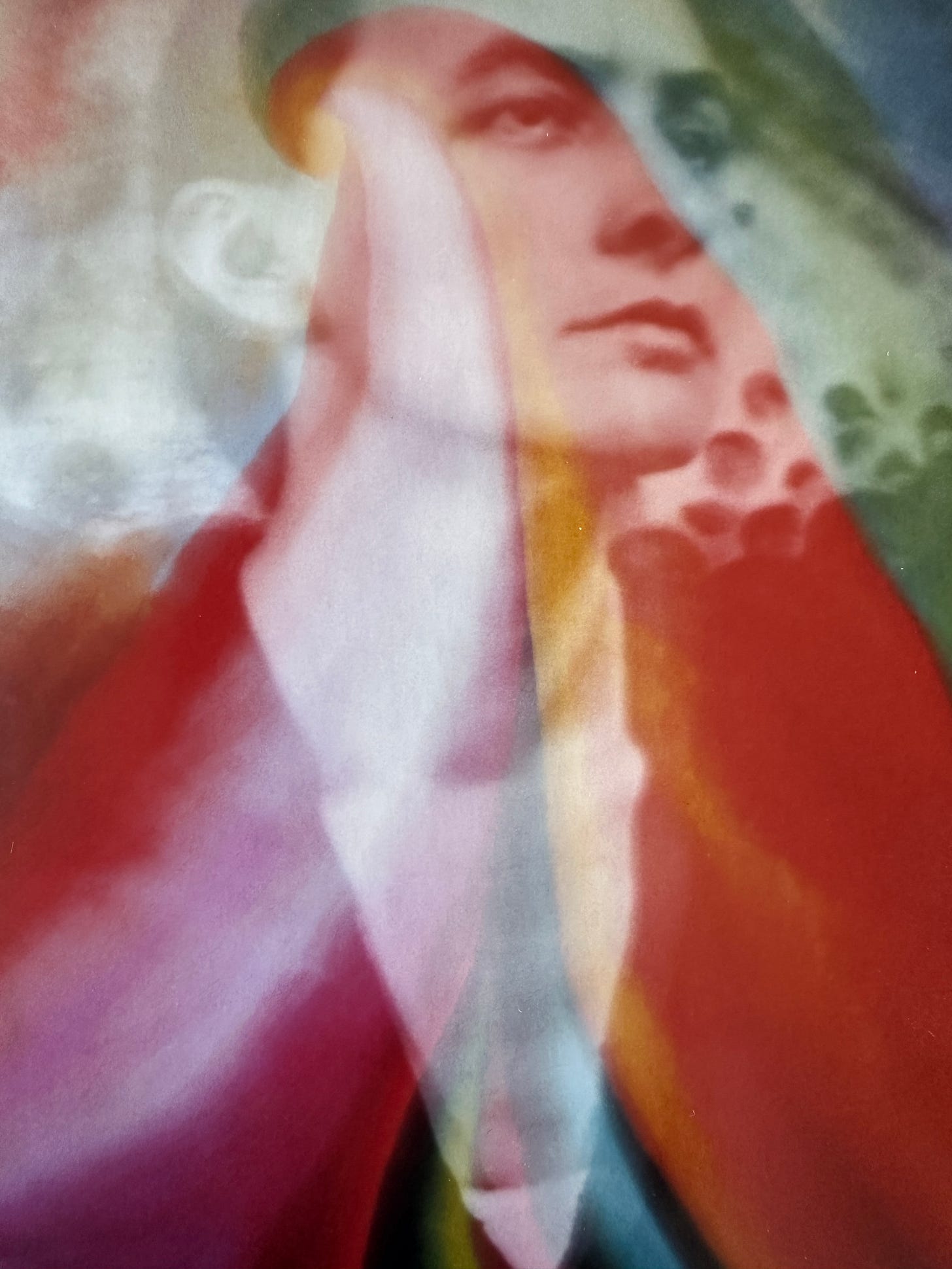
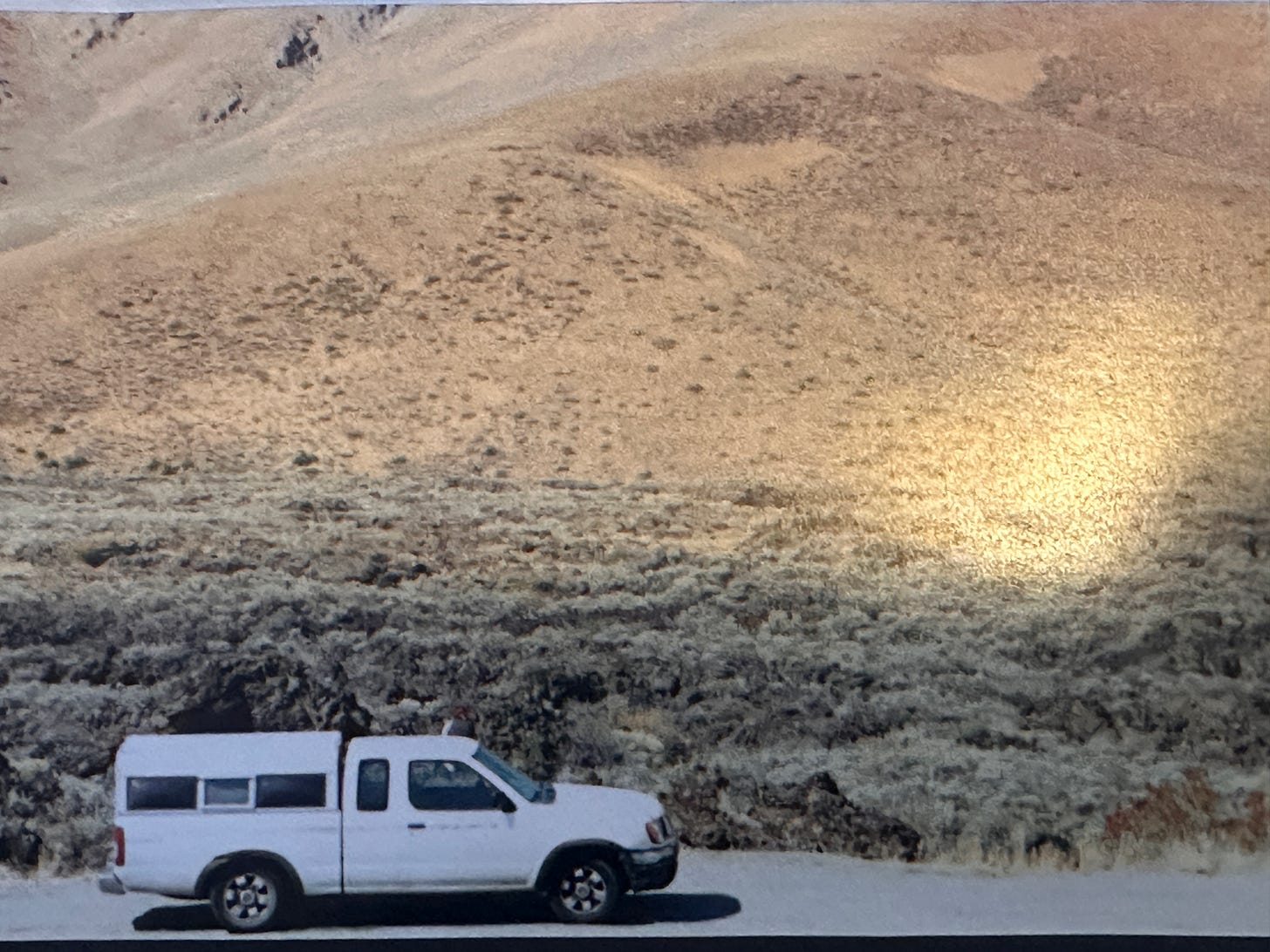

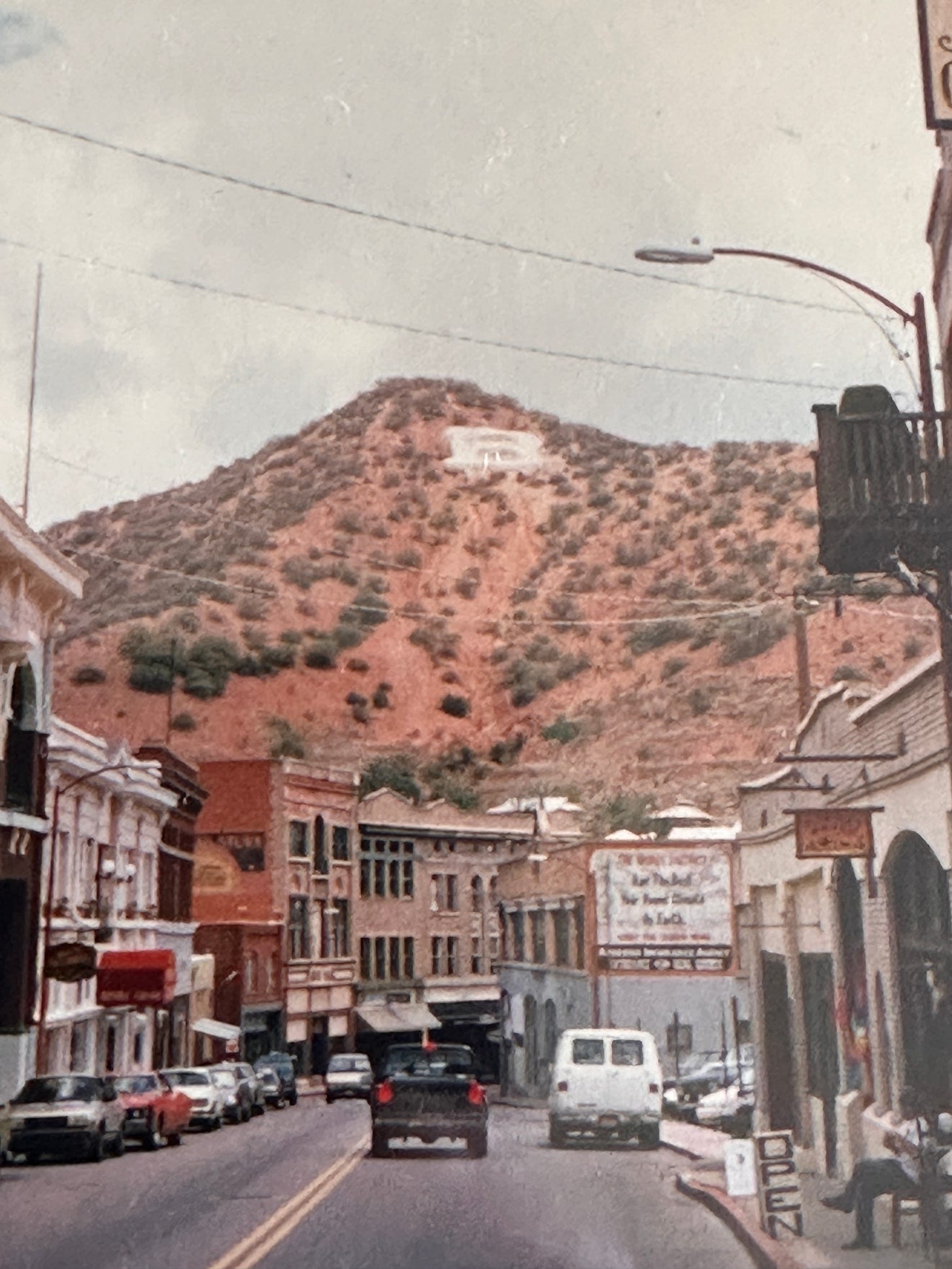



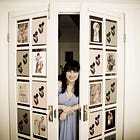
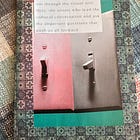
I really enjoyed reading this, thank you! It makes me wish I'd kept more of my own writing as a teenager - although I almost never finished any of the "novels" I wrote.